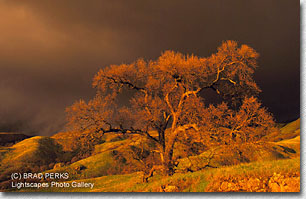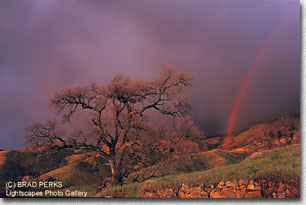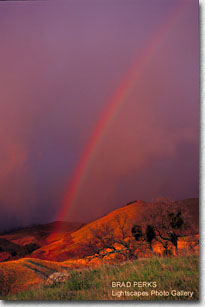|
|
 Photo Itinerary... Devil Mountain
Text Copyright and Photography Copyright Brad Perks Devil Mountain was named for the devilishly red color it turns at sunset. It rises 3849 feet above the coastal communities near San Francisco California. It is the single predominant feature among the gentle rolling hills and waterways of the East Bay Area. Atop its towering peaks you can see over a 100 miles to Half Dome in Yosemite National Park, and to Mount Lassen to the north. Devil Mountain is one of nine East Bay Area Regional Parks. Serious bikers find the vertical climb challenging, people on horseback ride through the gentle foothills, hikers enjoy the countless trails, while photographers are drawn to its continually changing beauty.
My favorite subjects to photograph on Devil Mountain are the magnificent oak trees, layers of green hills, wildflowers, the winter storms, and fiery sunsets. Spring is a good time to get your camera, a pair of comfortable hiking shoes and plan on spending the day on the mountain. The hills turn green in springtime after the winter rains. The valleys and hillsides come alive with patches of California Poppies and Purple Lupine. The oak trees burst into color as the vibrant green leaves first appear. You might even get lucky enough to see the single pair of Bald Eagles that finally returned again to nest in 1998.
I also use my computer help get great shots. The US Weather service provides information on the sun and moon. I simply enter in the city and a chart is generated for the entire year. I also calculate the position of the moonrise along the horizon. It's the High Tech way to be in the right place at the right time. Winter sunsets can look like "fire storms". These most colorful of sunsets occur when the sun meets the edge of a storm near the horizon. I watch out the window of my house for the right storm conditions. I also check the western satellite views provided by the US weather service on the Internet. I can keep a satellite eye on the storms progress as waves on rain come in off the Pacific Ocean. I am out the door if it looks like it might happen. Storm chasers get the best shots or nothing at all.
A “Rainbow Chase” on one particular occasion went something like this: It was pouring rain. I dashed out to Devil Mountain after the seeing sunny live pictures over San Francisco and checking the satellite view on the Internet. It was still raining when I arrived. I could see a sliver of light along the horizon. The sun dropped below the storm moments before sunset. Golden light illuminated an oak tree with a background of dark storm clouds. Next came a record cloud burst. I was being drenched with hail and rain as the colors of sunset disappeared in the distance. I went running for the car and glimpsed at a "Red Rainbow" in a purple sky behind me. I wiped the raindrops from my lens with my shirttail, grabbed three frames, and jumped into my car. My camera and I were soaked clean through with freezing rain. My favorite pictures on Devil Mountain are the sunsets and dramatic weather where timing is everything. Use your high tech tools to help you be in the right place at the right time. But even if you can’t dash out to take pictures like me, Devil Mountain is a great place to visit for spectacular views and spectacular pictures. It is also a popular area to picnic, bike, hike and watch wildlife. Tech info
Camera: Minolta 9xi About the images...
Thumbnail - "Devil Mountain in Springtime" Editor’s note: To learn more about Mount Diablo, you can visit the following web sites:
www.mdia.org/spinfo.htm Visit Brad's website to view more images of Devil's Mountain. |
|
|
 Mount Diablo, which means “Devil Mountain” in Spanish, became a State Park in 1931. It is 20 miles East of San Francisco, The South Gate is off Highway I-680 and Diablo Road in Danville. The road is slow going as it winds its way to the summit. A stone castle atop the mountain claims to have one of the world’s best 360-degree views. To the West you can see the San Francisco and the Pacific Ocean. To the South you can see the rolling hills of Livermore and Silicon Valley. Directly east is the Central Valley and the snow covered peaks of the Sierra Madre. To the North you can see the California Delta and the Redwood forests stretching up the California Coast. The drive to the top takes around 45 minutes if you don’t stop to take pictures along the way. I make frequent stops for photos and to enjoy the view. Picnic areas and a limited number of camping sites are available.
Mount Diablo, which means “Devil Mountain” in Spanish, became a State Park in 1931. It is 20 miles East of San Francisco, The South Gate is off Highway I-680 and Diablo Road in Danville. The road is slow going as it winds its way to the summit. A stone castle atop the mountain claims to have one of the world’s best 360-degree views. To the West you can see the San Francisco and the Pacific Ocean. To the South you can see the rolling hills of Livermore and Silicon Valley. Directly east is the Central Valley and the snow covered peaks of the Sierra Madre. To the North you can see the California Delta and the Redwood forests stretching up the California Coast. The drive to the top takes around 45 minutes if you don’t stop to take pictures along the way. I make frequent stops for photos and to enjoy the view. Picnic areas and a limited number of camping sites are available. When photographing landscapes on the mountain, I use Shing Ray neutral density filters with a Cokin P filter holder. I can then balance the colors of sunset with the green hills. Access your cameras spot meter to determine the difference in exposure between the sky and the foreground. The new honeycomb light meters do not seem to read the exposures as accurately with neutral density filters. Keep your camera on manual, use your spot meter, and bracket your exposures. I frequently combine a 2 and 3 stop filter when I need a total of 5 stops. I feather the edges to make a smoother transition when I am using more than one filter. Positioning your filters takes some practice. You want the picture to look natural instead of heavy-handed. I find it easier to zoom out, position my filter(s), and then zoom back in to compose my shot. With a little practice you'll be right on target.
When photographing landscapes on the mountain, I use Shing Ray neutral density filters with a Cokin P filter holder. I can then balance the colors of sunset with the green hills. Access your cameras spot meter to determine the difference in exposure between the sky and the foreground. The new honeycomb light meters do not seem to read the exposures as accurately with neutral density filters. Keep your camera on manual, use your spot meter, and bracket your exposures. I frequently combine a 2 and 3 stop filter when I need a total of 5 stops. I feather the edges to make a smoother transition when I am using more than one filter. Positioning your filters takes some practice. You want the picture to look natural instead of heavy-handed. I find it easier to zoom out, position my filter(s), and then zoom back in to compose my shot. With a little practice you'll be right on target. I also go on "Rainbow Watch" during the stormy time of year. Local television stations have web sites that provide live views of San Francisco and the Golden Gate Bridge. Most of the storms are heading west off the Pacific Ocean. Devil Mountain is 20 miles due east of San Francisco. When the sun comes out in San Francisco it usually means I have 20 minutes to head out in the rain, get in location and wait for the sun and rainbows to appear.
I also go on "Rainbow Watch" during the stormy time of year. Local television stations have web sites that provide live views of San Francisco and the Golden Gate Bridge. Most of the storms are heading west off the Pacific Ocean. Devil Mountain is 20 miles due east of San Francisco. When the sun comes out in San Francisco it usually means I have 20 minutes to head out in the rain, get in location and wait for the sun and rainbows to appear.